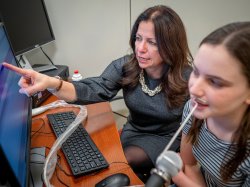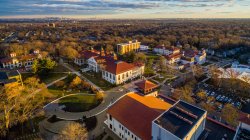Overcoming Childhood Speech Sound Disorders

While most children outgrow common speech sound disorders — such as producing a “w” for an “r” — others persist in making speech sound errors, which can create academic and social issues that can persist for years.
Clinical Biofeedback Laboratory founder Elaine Hitchcock is working to change that.
“Speech sound disorder in childhood poses a barrier to academic and social participation, with potentially lifelong consequences for educational and occupational outcomes,” says Hitchcock, an associate professor of Communication Sciences and Disorders.
She recently received a $271,000 sub-award for the first year of a five-year, $1.4 million collaboration with colleagues at New York University and Syracuse University for a study that will advance both the understanding of speech production as well as the remediation of residual speech errors in school-aged children.
Funded by the National Institutes of Health, Hitchcock’s project “Biofeedback – enhanced treatment for speech sound disorder” will meet a public health need by conducting the first randomized controlled trial that compares the efficacy and efficiency of speech intervention with and without real-time visual biofeedback.
“It will also test the hypothesis that the intervention efficacy can be optimized when biofeedback technology is selected to offset the learner’s primary deficit,” Hitchcock says.
The project will employ both undergraduate and graduate students, who will work with Hitchcock in the Clinical Biofeedback Lab testing children up to age 15.
